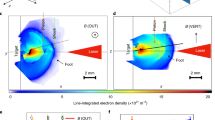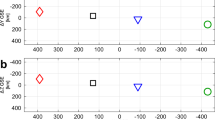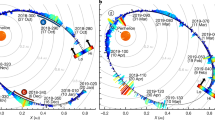Abstract
The acceleration of charged particles by collisionless shocks is a process of considerable importance in astrophysics, but the physical mechanism is not yet understood in detail. Energetic particles near interplanetary shocks may be studied in situ by spacecraft, but little is known about their distribution across the shock surface because of inadequate knowledge of the location of the sampling point in relation to the whole disturbance. A ground-based method has been developed2 which enables shock-associated disturbances to be mapped in three dimensions, and we have used it, in combination with near-Earth spacecraft measurements, to study how the particle flux varies for shocks travelling at different angles to the Sun–Earth line. We have observed a pronounced east–west asymmetry which indicates that the inclination of the interplanetary magnetic field to the shock surface must be a potent factor in the acceleration process.
This is a preview of subscription content, access via your institution
Access options
Subscribe to this journal
Receive 51 print issues and online access
$199.00 per year
only $3.90 per issue
Buy this article
- Purchase on Springer Link
- Instant access to full article PDF
Prices may be subject to local taxes which are calculated during checkout
Similar content being viewed by others
References
Tappin, S. J. Planet. Space Sci. 34, 93–97 (1986).
Gapper, G. R., Hewish, A., Purvis, A. & Duffett-Smith, P. J. Nature 296, 633–636 (1982).
Tappin, S. J., Hewish, A. & Gapper, G. R. Planet. Space Sci. 31, 1171–1176 (1983).
Tappin, S. J., Hewish, A. & Gapper, G. R. Planet. Space Sci. 32, 1273–1281 (1984).
Hewish, A., Tappin, S. J. & Gapper, G. R. Nature 314, 137–140 (1985).
Hewish, A. & Bravo, S. Sol. Phys. (in the press).
Nagai, T. & Kohno, T. Sol. terr. envir. Res. Japan 8, 20–33 (1984).
Tsurutani, B. T., Smith, E. J, Pyle, K. R. & Simpson, J. A. J. geophys. Res. 87, 7389–7404 (1982).
Evenson, P., Meyer, P. & Yanagita, S. J. geophys. Res. 87, 625–631 (1982).
Sanahuja, B., Domingo, V., Wenzel, K.-P., Joselyn, J. A. & Keppler, E. Sol. Phys. 84, 321–337 (1983).
Van Hollebeke, M. A. I., Ma Sung, L. S. & McDonald, F. B. Sol. Phys. 41, 189–193 (1975).
Sarris, E. T., Decker, R. B. & Krimigis, S. M. J. geophys. Res. 90, 3961–3965 (1985).
van Nes, P., Reinhard, R., Sanderson, T. R. & Wenzel, K.-P. J. geophys. Res. 89, 2122–2132 (1984).
Cane, H. V. J. geophys. Res. 90, 191–197 (1985).
Author information
Authors and Affiliations
Rights and permissions
About this article
Cite this article
Hewish, A., Bravo, S. Distribution of energetic particles near interplanetary shocks. Nature 324, 44–46 (1986). https://doi.org/10.1038/324044a0
Received:
Accepted:
Issue Date:
DOI: https://doi.org/10.1038/324044a0
This article is cited by
-
Observation of shock-accelerated protons by GIOTTO and IMP-8 under solar minimum conditions in February 1986
Solar Physics (1992)
-
Some comments on the east-west solar flare distribution during the 1976?1985 period
Solar Physics (1990)
-
On the E-W asymmetry of Forbush decreases (Ep ? 35 MeV)
Solar Physics (1989)
Comments
By submitting a comment you agree to abide by our Terms and Community Guidelines. If you find something abusive or that does not comply with our terms or guidelines please flag it as inappropriate.



